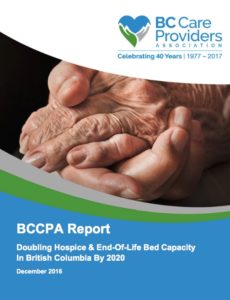By Lara Croll, M.A., BCCPA Policy Analyst

While talking about the end of someone’s life can be difficult, the simple fact is that dying is a large part of life. Over 330,000 Canadians die every year, and the Canadian Hospice Palliative Care Association estimates that each of these deaths affects five people on average, including friends and family.[i], [ii] Despite these high numbers, the Canadian Institute for Health Information (CIHI) reports that only 16 to 30 per cent of Canadians who die have access to, or receive, palliative or end-of-life care services, with access varying significantly depending on where you live.[iii]
In regards to accessing such services, British Columbia, with over 30,000 deaths per year, performs in the middle of the pack [iv] as CIHI estimates only 27.4% of decedents in BC were formally designated as palliative-care patients.[v] This is despite strong and growing evidence that access to a hospice-palliative care approach leads to better outcomes for patients and their family caregivers. And while research suggests that most people would prefer to die at home or in the community, 53% of British Columbians still die in hospital every year.[vi] These statistics hold true for almost every age category – only for the most elderly patients does the proportion dying in hospital go below fifty per cent (see Table 1).
While some of these hospitalizations in the final days of life may be necessary or unavoidable, these statistics suggest that there is a need for greater access to quality end-of-life care, particularly to support older adults to die in their preferred care setting – whether that be at home, or in another community setting such as long-term care. Specifically, while the cost of dying in Canada ranges from a low of $10,000 for a sudden death to between $30,000 and $40,000 for someone with a terminal disease (such as cancer or chronic obstructive pulmonary disease)[vii] it is estimated that compared to usual acute care, hospice-palliative care may save the health care system approximately $7,000 to $8,000 per patient.[viii]
The lack of access to high-quality palliative care is certainly problematic given that demand is expected to increase due, in part, to an ageing population and the increasing number of people living with chronic, life-limiting illnesses and co-morbidities. Furthermore, the broad need for high-quality end-of-life care is unlikely to be significantly affected by the recently legalized medical assistance in dying, given its restrictive eligibility criteria and limited appeal.
| Table 1: Deaths in British Columbia (2004-2008) | ||||
| Age (years) | Community (%) | Hospital (%) | Other (%) | |
| All | 45.5 | 51.0 | 3.5 | |
| 70-79 | 40.0 | 58.4 | 1.6 | |
| 80-89 | 47.6 | 51.8 | 0.8 | |
| ≥90 | 60.0 | 39.6 | 0.3 | |
| Dementia Diagnosis | 77.8 | 22.0 | 0.1 | |
| Source: Jayaraman and Joseph BMC Palliative Care 2013, 12:19 | ||||
The BC Ministry of Health has made some progress towards increasing high-quality palliative and end-of-life care, including releasing its Provincial End-of-Life Care Action plan in 2013, and perhaps most significantly, committing to double the number of hospice and end-of-life (EOL) care beds across the province by 2020.[ix] In effect, this commitment means that the province needs to expand upon the 262 community and 107 acute and tertiary beds that existed as of March 2016 by adding an approximately 375 beds distributed across all five regional health authorities.[x]

The BC Care Providers Association (BCCPA) applauds the Ministry’s commitment to address this important issue and in general supports the initiatives outlined above to increase hospice and EOL beds. In particular, in order to help enhance the delivery of EOL care, the BCCPA believes there must be a coordinated role between the continuing care sector, the Ministry of Health and the Health Authorities to ensure not only that end-of-life care capacity is expanded, but that it is done in such a way that is cost effective; enhances quality of life; respects patient and family choice; and provides a variety of care settings to support different populations in their final days of life.
As part of this commitment to ensure that older adults and their families have sufficient access to a range of care settings and services at end of life, the BCCPA has undertaken a review of excess and under-used capacity in the continuing care sector. In July of 2015 the BCCPA surveyed its members to establish the extent of vacant residential care beds and assisted living units in British Columbia. The BCCPA discovered that among its membership, which includes approximately 60 per cent of the non-government continuing care operators in BC, over 400 residential care beds and 300 assisted living suites were vacant (see Table 2). The vast majority of these beds and units were not funded by government and reserved for private-pay clients.
| TABLE 2: RESULTS FROM THE BCCPA’S 2015 VACANT BEDS SURVEY | ||
| HEALTH AUTHORITY | VACANT RESIDENTIAL CARE BEDS (% VACANT) |
VACANT ASSISTED LIVING UNITS (% VACANT) |
| Interior Health | 57
(3.7%) |
68
(12.2%) |
| Fraser Health | 316
(10.3%) |
186
(21.7%) |
| Vancouver Coastal | 8
(0.6%) |
12 (7.7%) |
| Island Health | 28
(1.7%) |
47 (10.9%) |
| Total | 409
(5.4%) |
313 (15.6%) |
| Note: there were no respondents for the Northern Health Authority. | ||

The BC Care Providers Association (BCCPA) believes that given the existing under-used capacity within the continuing care sector, some of these under-used beds could be transitioned into end-of-life (EOL) beds aimed at providing care for older adults. This would allow the province to take advantage of the existing physical infrastructure as well as the existing expertise of continuing care staff who work every day to provide high-quality care for frail and elderly residents in their final days of life.
Some additional supports, including funding to support the provision of appropriate medications and equipment, as well as enhanced palliative-hospice care training for nurses, health care aides and other care staff would also have to accompany this transition. Provided these supports are available, the BCCPA, as outlined in its latest policy paper on EOL, recommends that the Ministry of Health and Health Authorities work with the BCCPA and other stakeholders to:
- Better utilize the existing capacity within residential care sector by transitioning under-used beds to end-of-life (EOL);
- Establish between 100 and 150 new EOL beds within BC’s residential care homes by 2020, with the remaining beds to be added to existing hospices and hospitals;
- Support the adoption of new palliative and EOL care models, including where necessary, providing funding to improve the integration between continuing and end-of-life care; and
- To support the initiatives outlined above, redirect a portion of current acute care funding to the continuing care sector for these purposes.
While no one care setting will be able to meet the diverse needs of an entire population, allowing British Columbians to die in their preferred setting is the best approach, whether this is at home, residential care or a hospice. This is why the BCCPA supports the continued work of the Ministry of Health and the Health Authorities to expand the delivery and capacity of end-of-life and hospice-palliative care in BC. Given significant under-used residential care capacity and our ageing population, expanding the end-of-life care offered in residential care settings not only has the potential to result in health systems savings, but also to improve the overall experience of dying for the elderly and their families.
End Notes
[i] Quality End-of-Life Coalition of Canada. Blueprint for action 2010 to 2020. 2010, p. 2
[ii] Canadian Institute for Health Information, Health Care Uses at the End of Life in British Columbia. (Ottawa: CIHI, 2008). https://secure.cihi.ca/free_products/EOL_Report_BC.pdf
[iii] Canadian Institute for Health Information, Health Care Use at the End of Life in Western Canada (Ottawa: CIHI, 2007).
[iv] Statistics Canada. Table 102-0503 – Deaths, by age and sex, Canada, provinces and territories, annual (2012), CANSIM (database). (accessed: January 5, 2016)
[v] Canadian Institute for Health Information (2008). Health Care Use at the End of Life in British Columbia. Accessed at: https://secure.cihi.ca/free_products/EOL_Report_BC.pdf
[vi] Bio Med Central. Determinants of place of death: a population-based retrospective cohort study. Jyothi Jayaraman and Joseph BMC Palliative Care 2013, 12:19.
[vii] Fassbender K, Fainsinger R, Carson M, et al. Cost trajectories at end of life: the Canadian experience. Journal of Pain and Symptom Management, 2009; 38(1):75-80.
[viii] The Way Forward. Cost Effectiveness of Palliative Care: A Review of the Literature (December 2012). http://www.hpcintegration.ca/resources/discussion-papers/economic-review.aspx
[ix] Ministry of Health (2013). The Provincial End-of-Life Care Action Plan for British Columbia: Priorities and Actions for Health System and Service Redesign. Accessed at: http://www.health.gov.bc.ca/library/publications/year/2013/end-of-life-care-action-plan.pdf
[x] Open Information BC. Accessed at: http://www2.gov.bc.ca/enSearch/detail?id=7AFDBC16F15F42E289E9F7DDB0F80C40&recorduid=HTH-2016-63300





